PRM701 Project Management: Quality Control, Time Management Techniques
VerifiedAdded on 2023/06/11
|7
|1366
|162
Homework Assignment
AI Summary
This assignment for PRM701 Project Management Principles discusses how quality control measures in projects reduce defects and improve project processes, outputs, and objectives by ensuring project scope achievement, customer satisfaction, process improvement, production enhancement, reduced rework, and enhanced internal communication. It also compares and contrasts Gantt charts and Schedule Network Analysis as project time management techniques, highlighting their features in planning and managing projects throughout their lifecycle. The assignment references various sources on project management principles and practices.
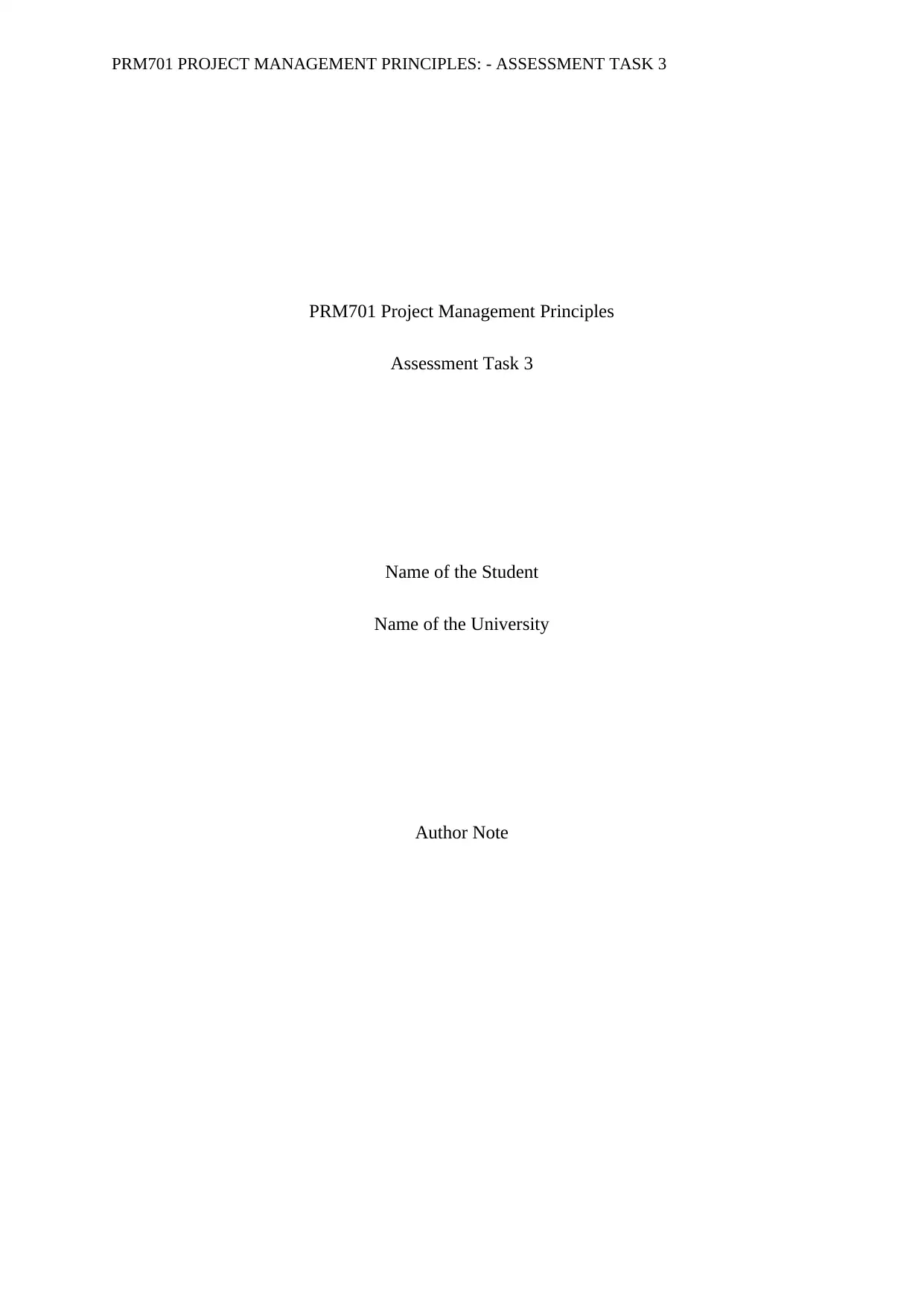
PRM701 PROJECT MANAGEMENT PRINCIPLES: - ASSESSMENT TASK 3
PRM701 Project Management Principles
Assessment Task 3
Name of the Student
Name of the University
Author Note
PRM701 Project Management Principles
Assessment Task 3
Name of the Student
Name of the University
Author Note
Paraphrase This Document
Need a fresh take? Get an instant paraphrase of this document with our AI Paraphraser
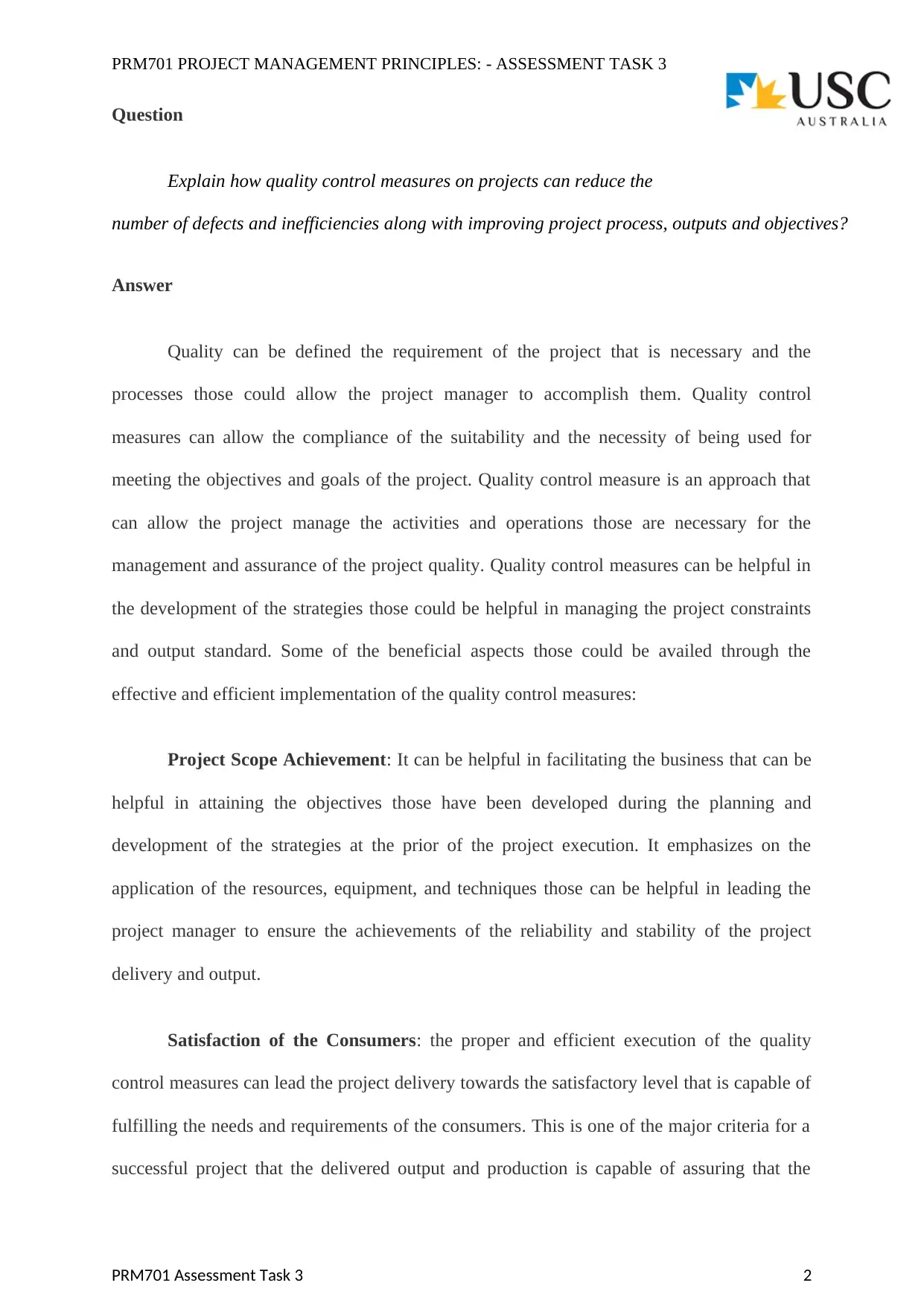
PRM701 PROJECT MANAGEMENT PRINCIPLES: - ASSESSMENT TASK 3
Question
Explain how quality control measures on projects can reduce the
number of defects and inefficiencies along with improving project process, outputs and objectives?
Answer
Quality can be defined the requirement of the project that is necessary and the
processes those could allow the project manager to accomplish them. Quality control
measures can allow the compliance of the suitability and the necessity of being used for
meeting the objectives and goals of the project. Quality control measure is an approach that
can allow the project manage the activities and operations those are necessary for the
management and assurance of the project quality. Quality control measures can be helpful in
the development of the strategies those could be helpful in managing the project constraints
and output standard. Some of the beneficial aspects those could be availed through the
effective and efficient implementation of the quality control measures:
Project Scope Achievement: It can be helpful in facilitating the business that can be
helpful in attaining the objectives those have been developed during the planning and
development of the strategies at the prior of the project execution. It emphasizes on the
application of the resources, equipment, and techniques those can be helpful in leading the
project manager to ensure the achievements of the reliability and stability of the project
delivery and output.
Satisfaction of the Consumers: the proper and efficient execution of the quality
control measures can lead the project delivery towards the satisfactory level that is capable of
fulfilling the needs and requirements of the consumers. This is one of the major criteria for a
successful project that the delivered output and production is capable of assuring that the
PRM701 Assessment Task 3 2
Question
Explain how quality control measures on projects can reduce the
number of defects and inefficiencies along with improving project process, outputs and objectives?
Answer
Quality can be defined the requirement of the project that is necessary and the
processes those could allow the project manager to accomplish them. Quality control
measures can allow the compliance of the suitability and the necessity of being used for
meeting the objectives and goals of the project. Quality control measure is an approach that
can allow the project manage the activities and operations those are necessary for the
management and assurance of the project quality. Quality control measures can be helpful in
the development of the strategies those could be helpful in managing the project constraints
and output standard. Some of the beneficial aspects those could be availed through the
effective and efficient implementation of the quality control measures:
Project Scope Achievement: It can be helpful in facilitating the business that can be
helpful in attaining the objectives those have been developed during the planning and
development of the strategies at the prior of the project execution. It emphasizes on the
application of the resources, equipment, and techniques those can be helpful in leading the
project manager to ensure the achievements of the reliability and stability of the project
delivery and output.
Satisfaction of the Consumers: the proper and efficient execution of the quality
control measures can lead the project delivery towards the satisfactory level that is capable of
fulfilling the needs and requirements of the consumers. This is one of the major criteria for a
successful project that the delivered output and production is capable of assuring that the
PRM701 Assessment Task 3 2
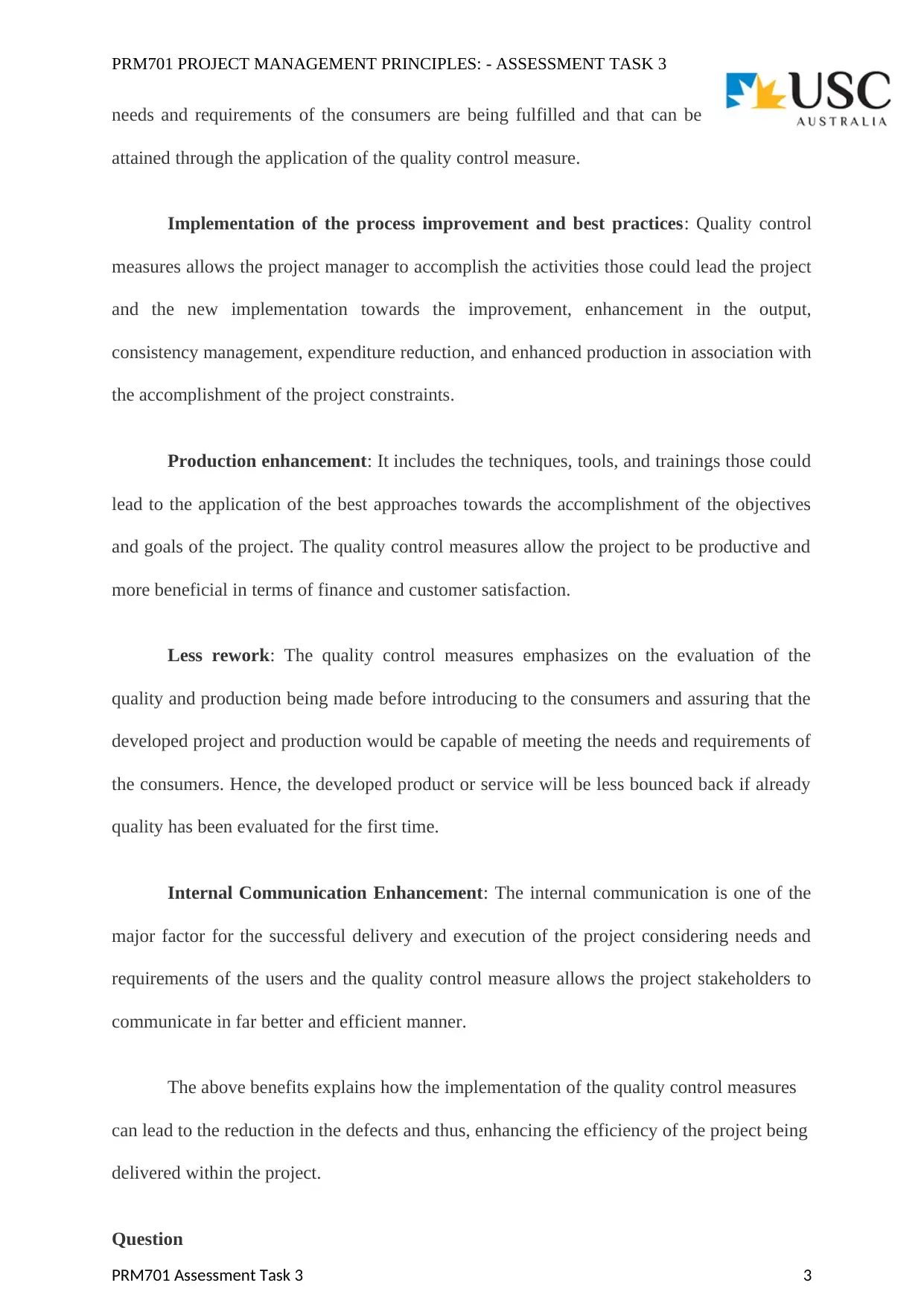
PRM701 PROJECT MANAGEMENT PRINCIPLES: - ASSESSMENT TASK 3
needs and requirements of the consumers are being fulfilled and that can be
attained through the application of the quality control measure.
Implementation of the process improvement and best practices: Quality control
measures allows the project manager to accomplish the activities those could lead the project
and the new implementation towards the improvement, enhancement in the output,
consistency management, expenditure reduction, and enhanced production in association with
the accomplishment of the project constraints.
Production enhancement: It includes the techniques, tools, and trainings those could
lead to the application of the best approaches towards the accomplishment of the objectives
and goals of the project. The quality control measures allow the project to be productive and
more beneficial in terms of finance and customer satisfaction.
Less rework: The quality control measures emphasizes on the evaluation of the
quality and production being made before introducing to the consumers and assuring that the
developed project and production would be capable of meeting the needs and requirements of
the consumers. Hence, the developed product or service will be less bounced back if already
quality has been evaluated for the first time.
Internal Communication Enhancement: The internal communication is one of the
major factor for the successful delivery and execution of the project considering needs and
requirements of the users and the quality control measure allows the project stakeholders to
communicate in far better and efficient manner.
The above benefits explains how the implementation of the quality control measures
can lead to the reduction in the defects and thus, enhancing the efficiency of the project being
delivered within the project.
Question
PRM701 Assessment Task 3 3
needs and requirements of the consumers are being fulfilled and that can be
attained through the application of the quality control measure.
Implementation of the process improvement and best practices: Quality control
measures allows the project manager to accomplish the activities those could lead the project
and the new implementation towards the improvement, enhancement in the output,
consistency management, expenditure reduction, and enhanced production in association with
the accomplishment of the project constraints.
Production enhancement: It includes the techniques, tools, and trainings those could
lead to the application of the best approaches towards the accomplishment of the objectives
and goals of the project. The quality control measures allow the project to be productive and
more beneficial in terms of finance and customer satisfaction.
Less rework: The quality control measures emphasizes on the evaluation of the
quality and production being made before introducing to the consumers and assuring that the
developed project and production would be capable of meeting the needs and requirements of
the consumers. Hence, the developed product or service will be less bounced back if already
quality has been evaluated for the first time.
Internal Communication Enhancement: The internal communication is one of the
major factor for the successful delivery and execution of the project considering needs and
requirements of the users and the quality control measure allows the project stakeholders to
communicate in far better and efficient manner.
The above benefits explains how the implementation of the quality control measures
can lead to the reduction in the defects and thus, enhancing the efficiency of the project being
delivered within the project.
Question
PRM701 Assessment Task 3 3
⊘ This is a preview!⊘
Do you want full access?
Subscribe today to unlock all pages.

Trusted by 1+ million students worldwide
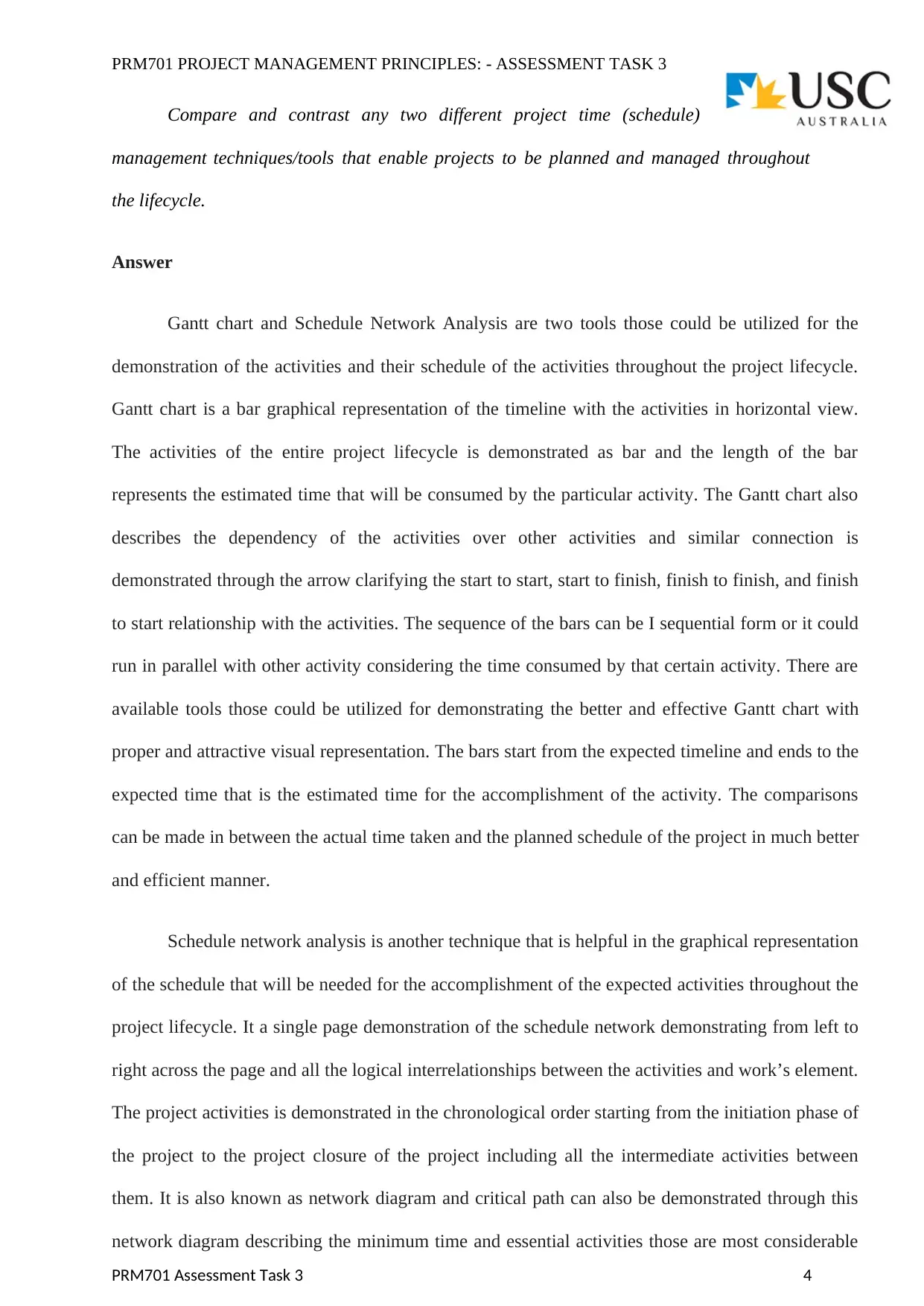
PRM701 PROJECT MANAGEMENT PRINCIPLES: - ASSESSMENT TASK 3
Compare and contrast any two different project time (schedule)
management techniques/tools that enable projects to be planned and managed throughout
the lifecycle.
Answer
Gantt chart and Schedule Network Analysis are two tools those could be utilized for the
demonstration of the activities and their schedule of the activities throughout the project lifecycle.
Gantt chart is a bar graphical representation of the timeline with the activities in horizontal view.
The activities of the entire project lifecycle is demonstrated as bar and the length of the bar
represents the estimated time that will be consumed by the particular activity. The Gantt chart also
describes the dependency of the activities over other activities and similar connection is
demonstrated through the arrow clarifying the start to start, start to finish, finish to finish, and finish
to start relationship with the activities. The sequence of the bars can be I sequential form or it could
run in parallel with other activity considering the time consumed by that certain activity. There are
available tools those could be utilized for demonstrating the better and effective Gantt chart with
proper and attractive visual representation. The bars start from the expected timeline and ends to the
expected time that is the estimated time for the accomplishment of the activity. The comparisons
can be made in between the actual time taken and the planned schedule of the project in much better
and efficient manner.
Schedule network analysis is another technique that is helpful in the graphical representation
of the schedule that will be needed for the accomplishment of the expected activities throughout the
project lifecycle. It a single page demonstration of the schedule network demonstrating from left to
right across the page and all the logical interrelationships between the activities and work’s element.
The project activities is demonstrated in the chronological order starting from the initiation phase of
the project to the project closure of the project including all the intermediate activities between
them. It is also known as network diagram and critical path can also be demonstrated through this
network diagram describing the minimum time and essential activities those are most considerable
PRM701 Assessment Task 3 4
Compare and contrast any two different project time (schedule)
management techniques/tools that enable projects to be planned and managed throughout
the lifecycle.
Answer
Gantt chart and Schedule Network Analysis are two tools those could be utilized for the
demonstration of the activities and their schedule of the activities throughout the project lifecycle.
Gantt chart is a bar graphical representation of the timeline with the activities in horizontal view.
The activities of the entire project lifecycle is demonstrated as bar and the length of the bar
represents the estimated time that will be consumed by the particular activity. The Gantt chart also
describes the dependency of the activities over other activities and similar connection is
demonstrated through the arrow clarifying the start to start, start to finish, finish to finish, and finish
to start relationship with the activities. The sequence of the bars can be I sequential form or it could
run in parallel with other activity considering the time consumed by that certain activity. There are
available tools those could be utilized for demonstrating the better and effective Gantt chart with
proper and attractive visual representation. The bars start from the expected timeline and ends to the
expected time that is the estimated time for the accomplishment of the activity. The comparisons
can be made in between the actual time taken and the planned schedule of the project in much better
and efficient manner.
Schedule network analysis is another technique that is helpful in the graphical representation
of the schedule that will be needed for the accomplishment of the expected activities throughout the
project lifecycle. It a single page demonstration of the schedule network demonstrating from left to
right across the page and all the logical interrelationships between the activities and work’s element.
The project activities is demonstrated in the chronological order starting from the initiation phase of
the project to the project closure of the project including all the intermediate activities between
them. It is also known as network diagram and critical path can also be demonstrated through this
network diagram describing the minimum time and essential activities those are most considerable
PRM701 Assessment Task 3 4
Paraphrase This Document
Need a fresh take? Get an instant paraphrase of this document with our AI Paraphraser
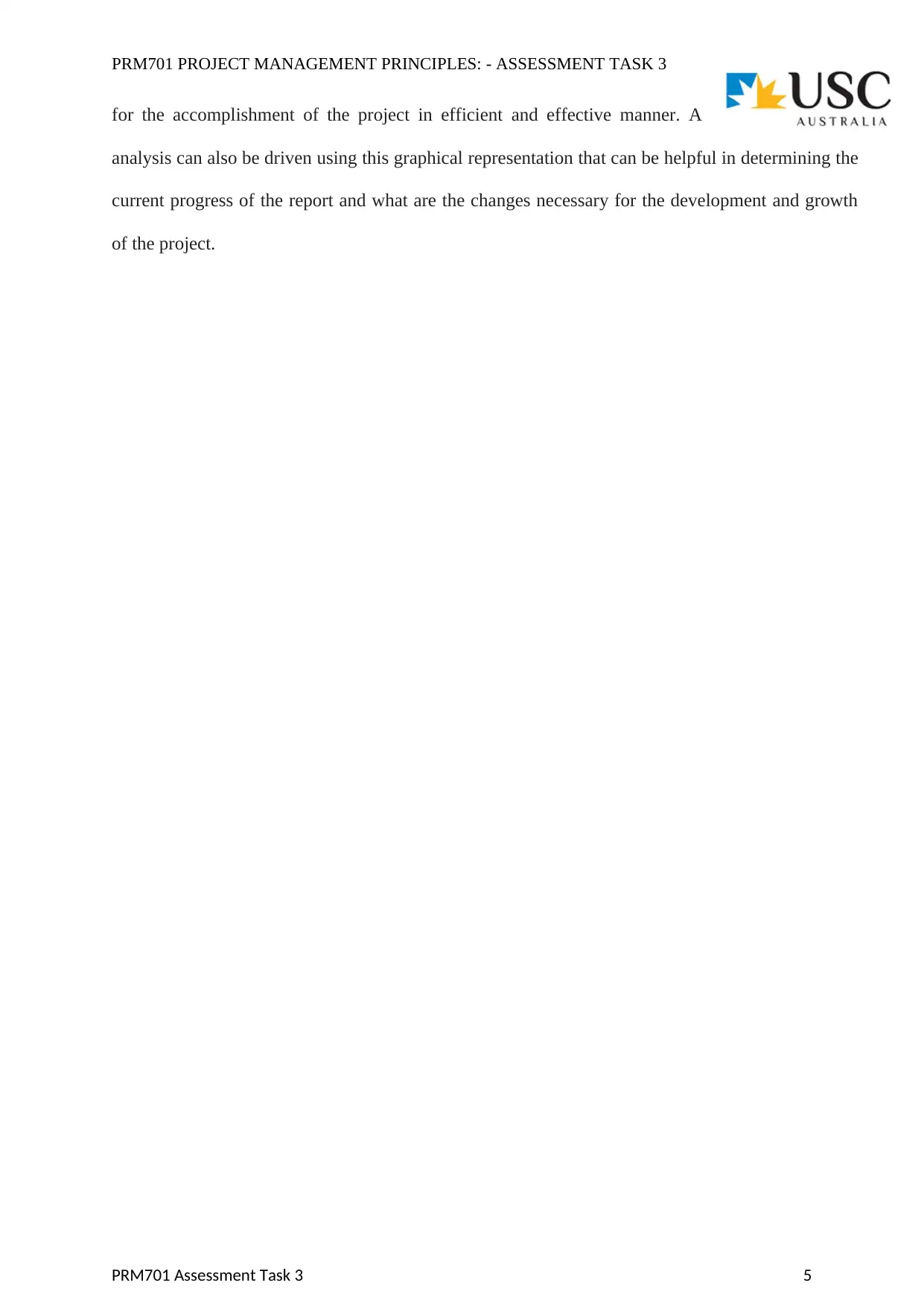
PRM701 PROJECT MANAGEMENT PRINCIPLES: - ASSESSMENT TASK 3
for the accomplishment of the project in efficient and effective manner. A
analysis can also be driven using this graphical representation that can be helpful in determining the
current progress of the report and what are the changes necessary for the development and growth
of the project.
PRM701 Assessment Task 3 5
for the accomplishment of the project in efficient and effective manner. A
analysis can also be driven using this graphical representation that can be helpful in determining the
current progress of the report and what are the changes necessary for the development and growth
of the project.
PRM701 Assessment Task 3 5
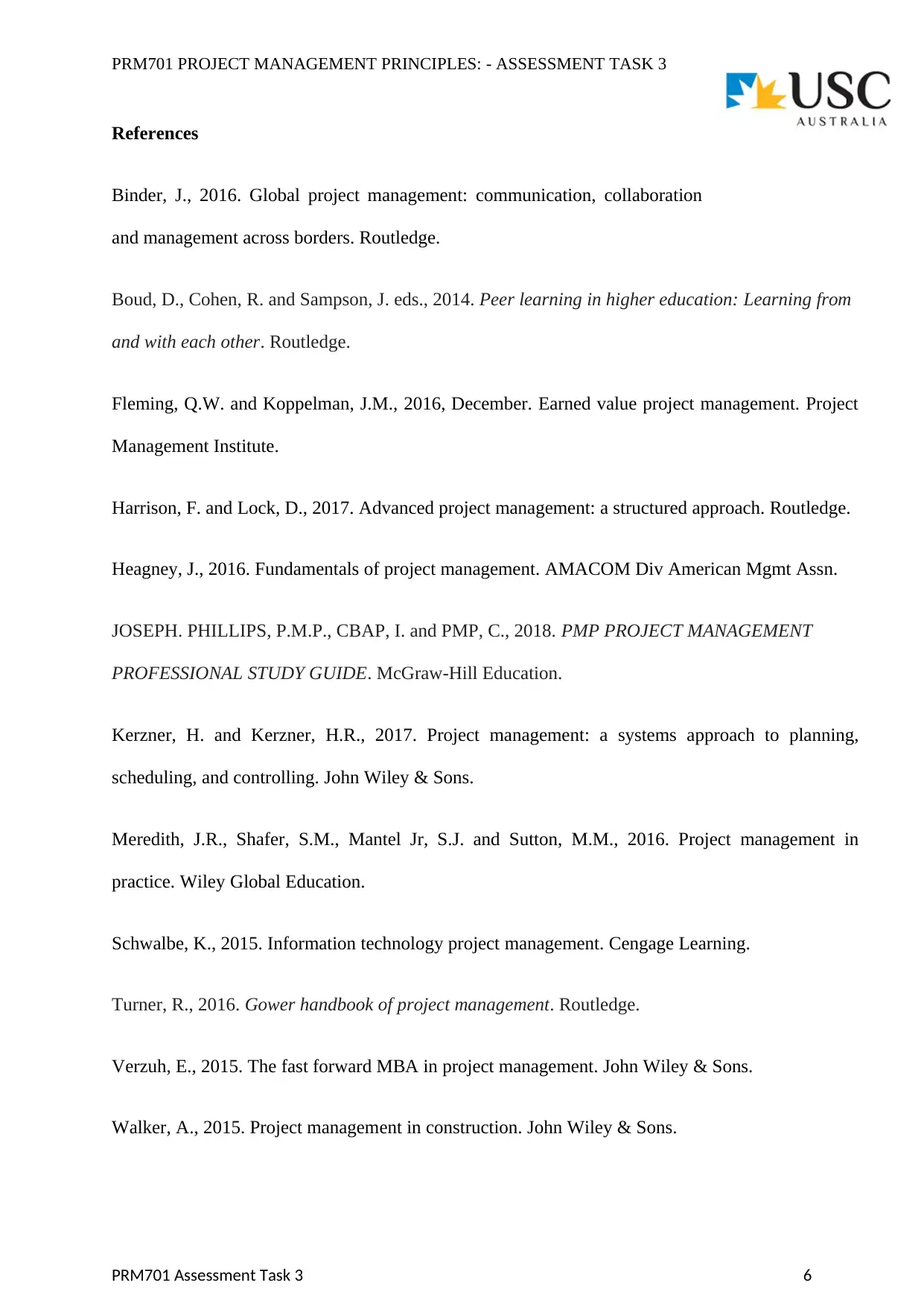
PRM701 PROJECT MANAGEMENT PRINCIPLES: - ASSESSMENT TASK 3
References
Binder, J., 2016. Global project management: communication, collaboration
and management across borders. Routledge.
Boud, D., Cohen, R. and Sampson, J. eds., 2014. Peer learning in higher education: Learning from
and with each other. Routledge.
Fleming, Q.W. and Koppelman, J.M., 2016, December. Earned value project management. Project
Management Institute.
Harrison, F. and Lock, D., 2017. Advanced project management: a structured approach. Routledge.
Heagney, J., 2016. Fundamentals of project management. AMACOM Div American Mgmt Assn.
JOSEPH. PHILLIPS, P.M.P., CBAP, I. and PMP, C., 2018. PMP PROJECT MANAGEMENT
PROFESSIONAL STUDY GUIDE. McGraw-Hill Education.
Kerzner, H. and Kerzner, H.R., 2017. Project management: a systems approach to planning,
scheduling, and controlling. John Wiley & Sons.
Meredith, J.R., Shafer, S.M., Mantel Jr, S.J. and Sutton, M.M., 2016. Project management in
practice. Wiley Global Education.
Schwalbe, K., 2015. Information technology project management. Cengage Learning.
Turner, R., 2016. Gower handbook of project management. Routledge.
Verzuh, E., 2015. The fast forward MBA in project management. John Wiley & Sons.
Walker, A., 2015. Project management in construction. John Wiley & Sons.
PRM701 Assessment Task 3 6
References
Binder, J., 2016. Global project management: communication, collaboration
and management across borders. Routledge.
Boud, D., Cohen, R. and Sampson, J. eds., 2014. Peer learning in higher education: Learning from
and with each other. Routledge.
Fleming, Q.W. and Koppelman, J.M., 2016, December. Earned value project management. Project
Management Institute.
Harrison, F. and Lock, D., 2017. Advanced project management: a structured approach. Routledge.
Heagney, J., 2016. Fundamentals of project management. AMACOM Div American Mgmt Assn.
JOSEPH. PHILLIPS, P.M.P., CBAP, I. and PMP, C., 2018. PMP PROJECT MANAGEMENT
PROFESSIONAL STUDY GUIDE. McGraw-Hill Education.
Kerzner, H. and Kerzner, H.R., 2017. Project management: a systems approach to planning,
scheduling, and controlling. John Wiley & Sons.
Meredith, J.R., Shafer, S.M., Mantel Jr, S.J. and Sutton, M.M., 2016. Project management in
practice. Wiley Global Education.
Schwalbe, K., 2015. Information technology project management. Cengage Learning.
Turner, R., 2016. Gower handbook of project management. Routledge.
Verzuh, E., 2015. The fast forward MBA in project management. John Wiley & Sons.
Walker, A., 2015. Project management in construction. John Wiley & Sons.
PRM701 Assessment Task 3 6
⊘ This is a preview!⊘
Do you want full access?
Subscribe today to unlock all pages.

Trusted by 1+ million students worldwide
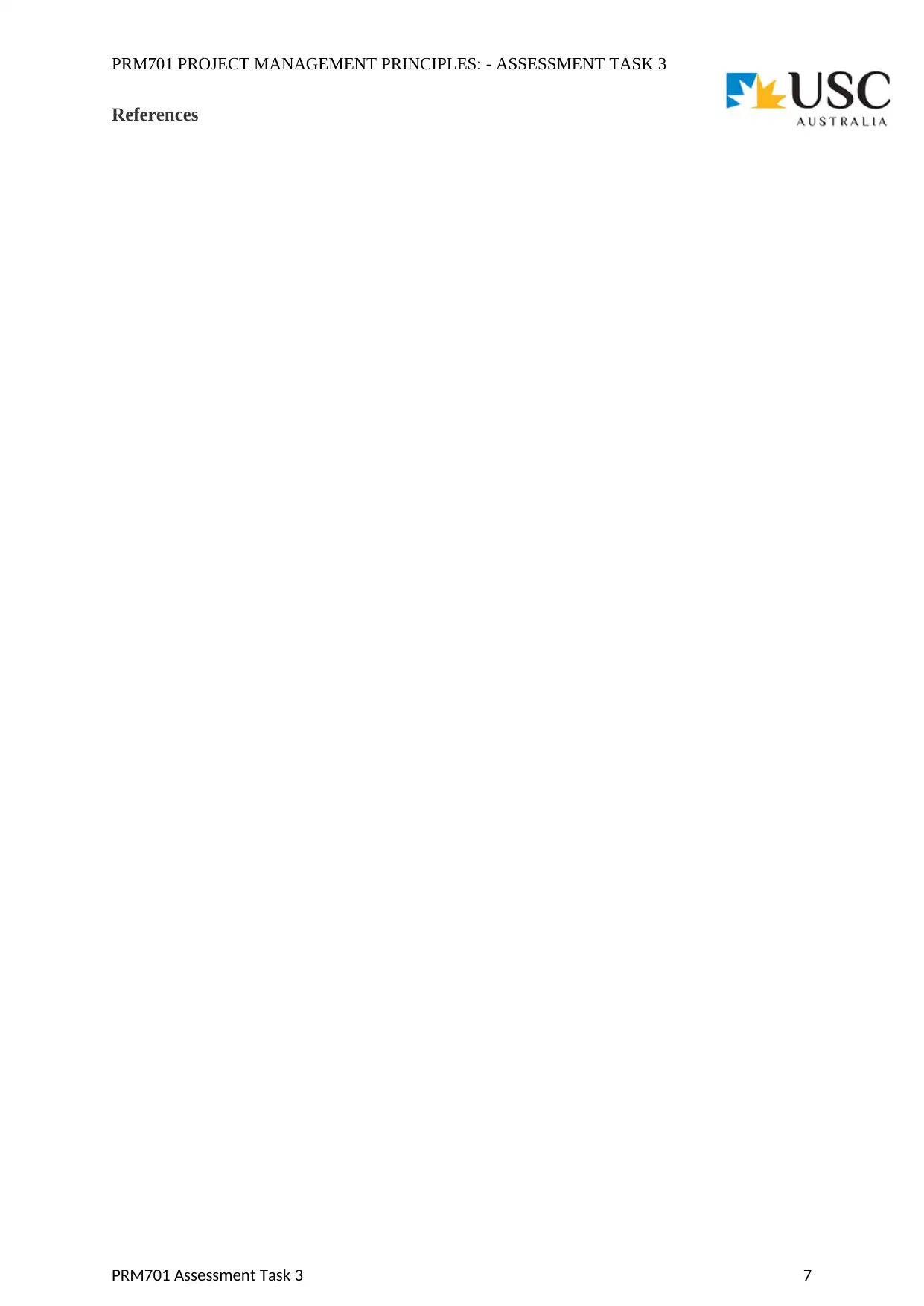
PRM701 PROJECT MANAGEMENT PRINCIPLES: - ASSESSMENT TASK 3
References
PRM701 Assessment Task 3 7
References
PRM701 Assessment Task 3 7
1 out of 7
Related Documents
Your All-in-One AI-Powered Toolkit for Academic Success.
+13062052269
info@desklib.com
Available 24*7 on WhatsApp / Email
![[object Object]](/_next/static/media/star-bottom.7253800d.svg)
Unlock your academic potential
Copyright © 2020–2025 A2Z Services. All Rights Reserved. Developed and managed by ZUCOL.

